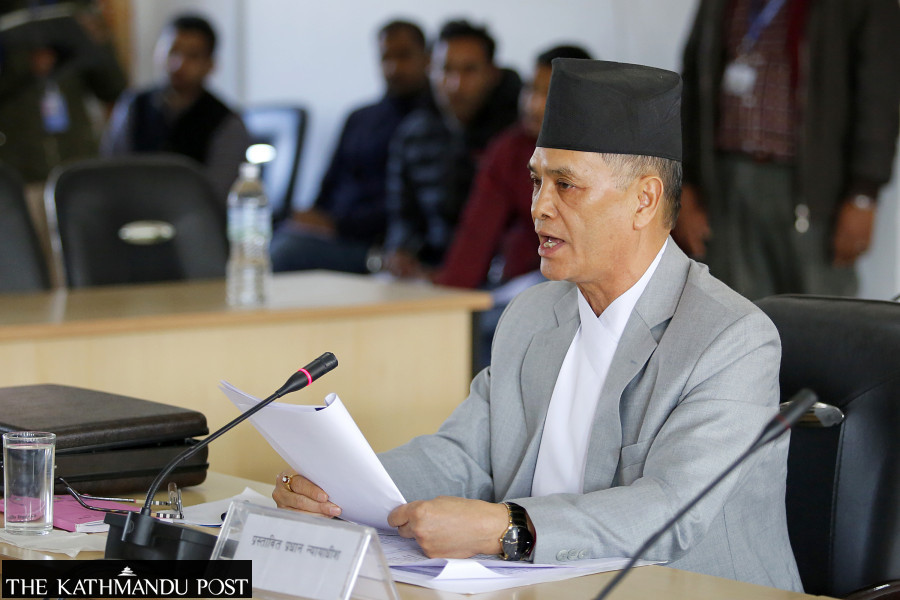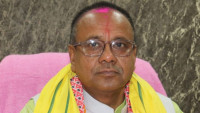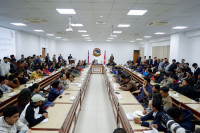National
With motion to impeach Rana tabled in the House, new questions arise
What will happen to justices and judges who have been charged with being complicit in corruption with the suspended chief justice, experts wonder.
Binod Ghimire
The impeachment motion against Chief Justice Cholendra Shumsher Rana has been tabled in the House of Representatives for further discussions, a month after it was registered in Parliament.
Dev Gurung, chief whip of the CPN (Maoist Centre), tabled the motion on Sunday, presenting 21 reasons why Rana should be impeached.
Rana remains suspended since February 13, the day 98 lawmakers from the Nepali Congress, the Maoist Centre and the CPN (Unified Socialist) registered the motion at the Parliament Secretariat.
One of the accusations against Rana, presented by Gurung on Sunday, is that the now suspended chief justice not only used his family members but also justices and judges as middlemen to commit corruption and make money through illegal means.
The same accusation is listed in the impeachment motion also that the lawmakers submitted on February 13 seeking to impeach him.
“Rana was involved in earning illegally through corruption and irregularities by mobilising his family members and relatives, and justices, judges and officials appointed by him,” reads one the allegation. “As a chairperson of the Judicial Council he failed to maintain transparency and made appointments arbitrarily.”
Other accusations include incompetence and incapability to perform the desired role as the chief justice and promoting corruption and anarchy in courts. The allegations supported by the lawmakers from the three ruling parties also claim that he misused his discretionary authority to fix the benches and finalise the cause list, thereby promoting corruption.
The way the three parties had moved the impeachment motion had raised quite some eyebrows with the main opposition seeing some ulterior motive.
Now that the motion has formally been tabled before the lawmakers to decide, constitutional and legal experts are wondering what should be the fate of those justices and officials who the 98 lawmakers say “played complicit roles” with Rana.
According to them, if what the 98 lawmakers of the sovereign Parliament are claiming is right, actions should be taken against those as well who colluded with Rana in promoting corruption.
“The claim has created a moral and legal obligation for the parties and the lawmakers to take action against those who they assert have supported in promoting corruption and malpractices in the judiciary,” senior advocate Dinesh Tripathi, chairperson of the Constitutional Lawyers’ Forum, told the Post. “They cannot just make claims and run away.”
As many as seven justices have been appointed in the Supreme Court since Rana in January 2020 became chief justice while around two dozen have been appointed high court judges. The number of district court judges appointed by the Judicial Council led by Rana is even higher.
Rana’s role as the chief justice first came into question in October when as many as 19 Supreme Court justices refused to attend benches, demanding that the lottery system for preparing the cause list be implemented as suggested by the study panel led by justice Hari Krishna Karki.
Charges against Rana were that he was misusing the prerogative of assigning cases by choosing justices of his choice.
Lawyers then joined in the justices’ protest, alleging that Rana is corrupt and that they would not participate in hearings unless he resigned. The crisis in the judiciary continued for months, with hearings stalled until December 1.
Political parties, however, dragged their feet, ignoring calls from lawyers to move an impeachment motion against him.
After the lottery system was introduced, justices returned to benches to hear cases, but lawyers continued their protest.
And suddenly on February 13, three parties from the ruling coalition registered the impeachment motion.
On March 6, Parliament formed an 11-member impeachment recommendation committee to investigate allegations against Rana.
Now questions have arisen as to what happens to those who are said to be complicit with Rana if the committee finds all charges against Rana valid and justified.
The lawmakers, who have made the claims, however, don’t have a clear answer to whom they want to indicate in their allegations. They were not clear if actions will be taken against those who they claim to have been partners of Rana in corruption.
“It is known to all that Rana was involved in corruption in collusion with other justices, judges and officials. He made them work as middlemen,” Gurung, who is one of the proposers of the motion, told the Post. “Now, as he is not in the court, the tendency has stopped.”
Gurung did not offer any examples to show that “the tendency has stopped.”
Asked if the lawmakers have proof to claim that other justices and judges acted as middlemen, Jeevan Ram Shrestha, chief whip of the Unified Socialist, said, “Senior advocates and advocates themselves have made the claims in their speeches. Why can’t we trust them?”
Rudra Prasad Pokharel, treasurer of the Nepal Bar Association, however, said lawmakers cannot say they made the charges based on hearsay.
“They have to take action against other justices and judges also who they claim were involved in supporting Rana in corruption,” Pokhrel told the Post. “If they don’t, it should be understood that they lied to Parliament. You cannot lie to the representatives of the sovereign people.”
Constitutional and legal experts say there is no denying that the judiciary is in an urgent need of reform. But there are systemic problems, and actions against a judge or two won't be enough to get rid of the rot that has set in deep.
If the lawmakers believe other justices too were involved in corruption, according to Tripathi, impeachment motions must be lodged against them also.
If lawmakers know very well the judges who they say were complicit with Rana, the Judicial Council should start investigation, said Tripathi.
“A comprehensive reform is necessary in the judiciary and impeachment motion against Rana is just one step towards it,” he told the Post.
Now that the impeachment motion against Rana has been tabled in the House, the committee has to investigate each and every allegation made against him.
As per the procedure, Rana will get a chance to defend himself.
As per Rojnath Pandey, spokesman for the Parliament Secretariat, deliberations on the motion are likely to conclude at the Wednesday’s meeting of the House and the details will be sent to the impeachment recommendation committee for studying the issue.
The committee can spend up to three months to investigate the allegations. The investigation report is then presented to the House, which can allow additional 15 days if necessary. But there is no deadline for putting the motion to a vote.
To impeach Rana, a two-thirds of the members of the 271-strong lower house at present have to vote in favour. That means 181 lawmakers must vote in favor of the motion. As the Nepali Congress (61 lawmakers), the Maoist Centre (49 lawmakers) and the Unified Socialist (23 lawmakers) together have 133 votes combined, support of an additional 48 lawmakers is a must.
The motion cannot get through without the support of the UML, the single largest party in Parliament, which has 97 lawmakers.
Constitutional experts say every allegation must be investigated before the impeachment motion is put to a vote.
“There has to be a thorough investigation of all the allegations and Rana should be allowed a chance to defend,” Chandra Kant Gyawali, a senior advocate who specializes on constitutional matters, told the Post. “Only those allegations that are established have to be put forth before the House when the motion is put to a vote.”
A justice at the Supreme Court said that the allegations must be backed by facts.
According to the justice, who spoke on the condition of anonymity, if the claims that other judges appointed by the Judicial Council chaired by Rana acted as middlemen are correct, then they should also be brought to book.
“These are serious allegations which cannot be made based on hearsay. Now the Parliament has the challenge to prove the allegations,” said the justice. “There are many allegations in the list of 21 which don’t qualify to be the reasons for impeachment.”
One of the allegations, for instance, says Rana didn’t take initiatives to implement the report by Justice Karki that said there is corruption in the judiciary .
“However, the full court has never accepted the report and there is no obligation to implement a report which the court has not accepted,” said the justice.




 20.12°C Kathmandu
20.12°C Kathmandu















